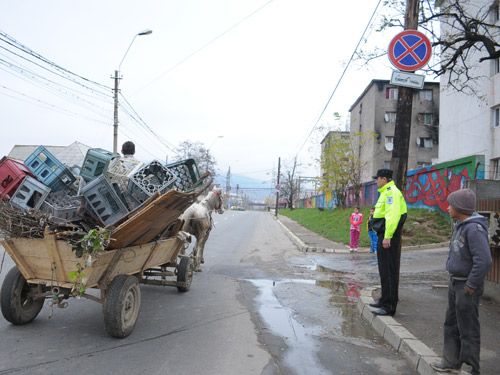After passing the brass forest, from Dristor to Matei Ambrozie, with tram 23 or 27, and get out at Râmnic market (the agroalimentara), right before Voluntarilor, as you step onto the beautiful ratty white platform of the station, you see the widening Liviu Rebreanu boulevard, a view that can be mistaken for a thousand others, linking Camil Ressu to Câmpia Libertății. On the right, leaving behind the rows of post-Chruščiovas blocks of flats that seem to be slowly grazing in the quiet morning, you enter Titan Park. And Titan Park begins with a fence, a grated fence. But on the Liviu Rebreanu side, the park offers something more. Here we have graffiti panels. These panels are only temporary „exhibited” in order to hide the unaesthetic look of cranes, bulldozers and hammer drills that are plotting to build a new residential center with a mall. Until then however, they might violently attack the eyes and ears of the unsuspecting pedestrian community or people passing through. The graffiti intervention doesn’t seem spontaneous, it doesn’t appear to be the artistic reaction of the sub cultural community living nearby, but rather the work of those legal eagles hired by the development firm.
This is precisely the function of the wall built by town hall in Baia Mare, on Horea street, Bloc 46 A and B, with the help of a development firm and their ever present partners – the legal eagle graffiti artists. Of course, the most handy verdict one can give would be that the place has been ghettonized, but beyond the fact that whoever gave the verdict is obsessively preoccupied because of the size, or well, the entho-racial origin of the local community, the verdict also offers a very noble, almost transcendental function to town hall’s gesture, a function that the gesture itself doesn’t really have, or ever possibly exist. It seems that the local authorities were facing a high rate of criminality amongst pick pockets, bag thieves and other small criminals for some time, due to the easy access to the National Road, thus the local funds allocated for fixing this social dysfunction went into buying a door mat, a broom and a dustpan. Clearly a reform would have been far more costly, without the guarantee that the (un)aesthetic aspect would change. And besides, we already know from the developers that the wall is a much more efficient method, just like a speculative from of passive profit: minimal investment, cheap work labor, short time of production, maximum short term and long profit at the same time. The metaphor, if there is one, isn’t the ghetto, but a box with little pink dots that doesn’t sell the product any better, but it guarantees the sale. It sells it to the public opinion, to the artistic community and to any other form of committee that would ever bother holding someone accountable for the bill after the line has been drawn.
As for myself, I won’t give any verdicts, because they come with responsibilities, instead I will only suggest a few harmless and irresponsible directions for discussion. The first one is, obviously, the one I just mentioned. It seems that for the local authorities the priority wasn’t lowering the criminality rate or raising the standard of living, it was only the visual aspect. If you can’t see it, it doesn’t exist. The second would be the story of the commissioned art work. The underprivileged emerging artists are simple minded, and in a way, they chose the National Road side of the wall to reproduced and restage what was happening to the people living on the other side of the wall: trying to make ends meet day by day, and town hall, let’s be honest here, isn’t their first, last or even the most significant public commissionaire. The discussion should probably begin with the sharks of public commissions, or their champion – The Romanian Orthodox Church. Pretend curator The Blessed Daniel, same as pretend art critic Cătălin Cherecheș, is noteworthy in this field, and if he won’t be sanctified while still alive by the institution he runs, sculptors, saint painters, monuments and other votive effusions will certainly do it. Even so, with the situation being as it is, and moving on to the third direction of discussion, maybe it wouldn’t hurt to ask about the origin of the artistic commission. What’s more useful for the community you activate in as an artist? A piece that has been funded by public money even if it has a false fate, a box with pink dots, or a work made with .INC money that quietly sits in the jacuzzi living room of a two floor office? The first example arouses discussions, like the one we’re having right now. As for the second – it doesn’t arouse anything, not even indifference.
POSTED BY
Igor Mocanu
Igor is a PhD researcher in the Art History department of the National University of the Arts Bucharest / UNARTE, with a dissertation titled Political avant-garde. The other face of Romanian avantgard...
igormocanu.wordpress.com



Comments are closed here.